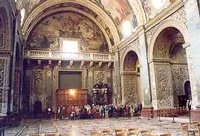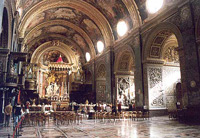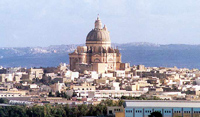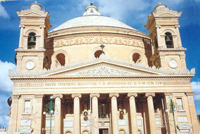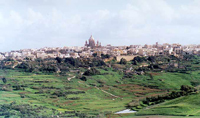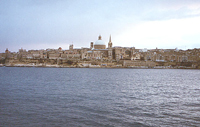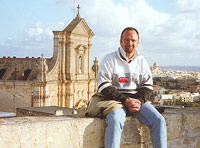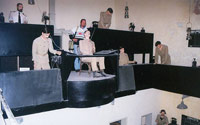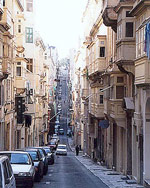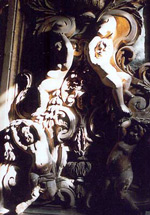Maltese Christmas (2004)
Christmas in Tunisia is the antithesis of that in the UK. Being a Muslim country there is no Christmas cheer but also no rampant commercialism. The only similarity is the weather - cold, damp and grey. We decided to risk the commercialism and enjoy a bit of Christmas spirit by heading to Malta for a week. Within a few hours of leaving our cold damp house we were enjoying a bit of luxury, having managed to get a good deal over the internet at the four star Radisson. I must admit I wasn't really expecting too much from Malta. I thought we'd be elbow to elbow with cheap package tourists and squaddies queuing up at fish and chip shops and reading the international Daily Express. I was very pleasantly surprised. On our first morning we took the courtesy bus into Valletta, a fortress of a town squeezed onto a finger of rock jutting into the aptly named Grand Harbour. It may have been a fortress but the buildings were softened by their honeyed glow in the early morning sunshine. It's a very pleasant town, and compact (the suburbs outside the town however seem to sprawl for miles). Within the city walls there is a series of parallel roads snaking up and down the contours of this hilly enclave. Although most of these narrow roads seemed lined with cars there is little traffic and few people so it was pleasant to step into the road without fear of being mowed down by some hoon in his Ford Escort or Mini.
The narrow streets are lined with five storey houses with windows jutting out over the street rather like the mashrabiya windows of Arabic towns. There are also plenty of churches. One of the more famous is the St. Paul's Shipwreck church, notable for me in being the only terraced church I had ever seen. It was simply part of a row of terraced houses, space being at such a premium.
Similarly enclosed on all sides, the St. John's Co-cathedral is not so impressive from the outside. However when you enter this Tardis-like building you are soon overwhelmed by its huge ornate baroque interior. Once I got to grips with the opulence of its vast frescoed interior I then noticed that it was also rather ghoulish. Many of the memorials to the Grand Masters, the knights of Malta, exuded an interesting mixture of death and immortality, good and evil, decay and rebirth for they were decorated with angels and ghouls, skeletons, skulls and eagles. Not only in the deep past, but Malta’s militaristic background has come to the fore in more recent times.
Every British schoolboy knows that Malta was awarded the George Cross in World War II. Hence the ‘Wartime Experience’, one the many audiovisual shows which seemed to have sprouted all over town, catering to the hordes of tourists no doubt. There were hordes of tourists in Valletta, but only five of us witnessed this particular experience. It was similarly quiet during my trip to the Lascaris War rooms – a warren of tunnels deep under Valletta and the nerve centre for the allied Mediterranean fleet in WWII. I was distinctly outnumbered by the many waxwork figures who were still plotting the downfall of the Third Reich.
After the historical, claustrophobic atmosphere of Valletta and the Grand Harbour, it was time to explore the hinterland. Not much of a hinterland size-wise it must be said. Apparently over one million visitors descend every year on this speck of 300 square kilometres. However most of this million are not around at Christmas so it was very pleasant touring the island on its narrow pot-holed roads. It is a small island but somehow it actually seems even smaller when travelling around.
On the central plain you can almost see the whole island: a treeless, barren countryside, dotted with villages each one having an enormous church sprouting from its core and boasting to its neighbours. Mosques and minarets in Islamic countries defiantly stand out for their religion: they are always the most visible of buildings in any town. Malta is the same. Its devout Christianity is visible from all angles. At first glance it may therefore seem odd that two of Malta's highlights are called Mdina and Rabat - Arabic words. Not so surprising though as Malta has been fought over many times and was an Arabic stronghold for over 200 years around the tenth century.
The Maltese language itself is derived from Arabic. Mdina and Rabat are inland versions of Valletta. Medieval walled cities and worth a stroll around narrow lanes. Having done the history, it was time for a bit of the present and that meant presents. The hotel was round the corner from Paceville (pronounced Patchyville!) and St. Julian’s Bay. In summer the focal point for the hordes of tourists. In the winter sun it was much more agreeable and quieter. A leisurely walk around the coast took me to Sliema, a not-unpleasant middle class district. Here were situated the British chain stores and the target for the present buying.
On the way back to the hotel I indulged myself in a pint of John Smiths bitter while watching Premiership football in one of the many Irish pubs dotted around. After all, despite sneering at the package tourists, a British male can’t turn up the chance of warm beer and football can he?
So overall Malta was a pleasant surprise. Not least the food. I contemplated this as I dined on stewed rabbit (a local speciality) and looked out over the twinkling lights of Spinola bay. I suppose it was apt that the Manchester United football team and Oliver Read also contemplated this scene. They were looking out from their autographed photos on the walls of a restaurant in this most anglophile of Mediterranean islands.



